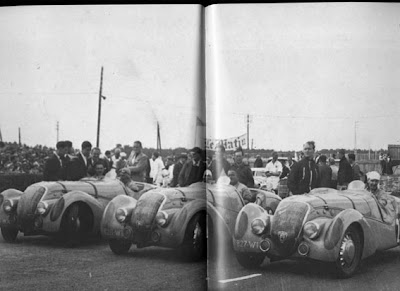The simplest of motoring pleasures is to plant your right foot firmly down on the accelerator pedal and sit back and enjoy the fun as the big motor gets going. But what about those cars which don't give all that many jollies via your heavy right boot? A Renault 4CV for example. A whole generation of people starting off in the late 1940s and continuing on into the 60s had a whale of a time riding their 750ccs worth of four mighty horses all over Europe in particular. And so I had to have some Renault 4CVs in my diecast collection. I love driving small, underpowered cars, pushing them to their limits, taking on much bigger competitors, and that was the appeal of not only the Renault 4CV, but so many cars of that era.
 |
| Here's the prettiest of my 4CVs, a 'decouverte' soft top model. The 1:43 model is by IXO. |
 |
| More recently I came across this sextet of 4CVs for sale on eBay, and for the princely sum of $5.50 each, including postage, they were mine. As usual, all are 1:43 scale, and all are made by Eligor. |
 |
| These are 'barquettes', special streamliners based on Renault 4CVs. On the left is the famous Bosvin-Michel Special, built by Camille Bosvin and driven by Guy Michel in various races in the 50s, include the Bol d'Or 1950-53, the Mille Miglia 53-55, Le Mans in 1954, the 12 Hours at Rheims 53-54, Targa Florio 55 and many others. The car on the right is the Rispal Barquette, which competed at Le Mans in 1955. |
 |
| Here's the Guy Michel car competing at the Bol d'Or in 1953, to give you some idea of the tiny size of these 750cc cars. Michel won in 1952 and 1953, in 1953 covering 2518km at an average speed of 104.9 km/h. And here's the scary bit. He drove alone for the whole 24 hours. They changed the rules to make multiple drivers mandatory after that. |
 |
| On the left is the 4CV Berline which competed in the 1952 Bold d'Or, where it placed eighth. And on the right is the Type R 4CV driven by Gamot and Maeght in the Tour of Belgium in 1953. Not sure how they went, though. |
 | ||
| All I know about the car on the left is that it was driven by Mr and Mrs Clark from New York to Los Angeles in 1956. Judging by the lack of numbers and the many sponsor's stickers, it looks like a promotional long-distance 4CV. On the right is the 4CV which competed in the Liege-Rome-Liege Rally in 1955. The 4CV won this long, arduous rally that went from Belgium to Italy and back to Belgium, crossing the Alps twice, in 1952. 4CVs also won the 1949 Monte Carlo Rally, and the first four places in the 53 Monte Carlo. |
 | |
| Quite a few 4CVs made it Australia, where they earned a reputation for durability that Australian roads don't hand out very easily. |
















































